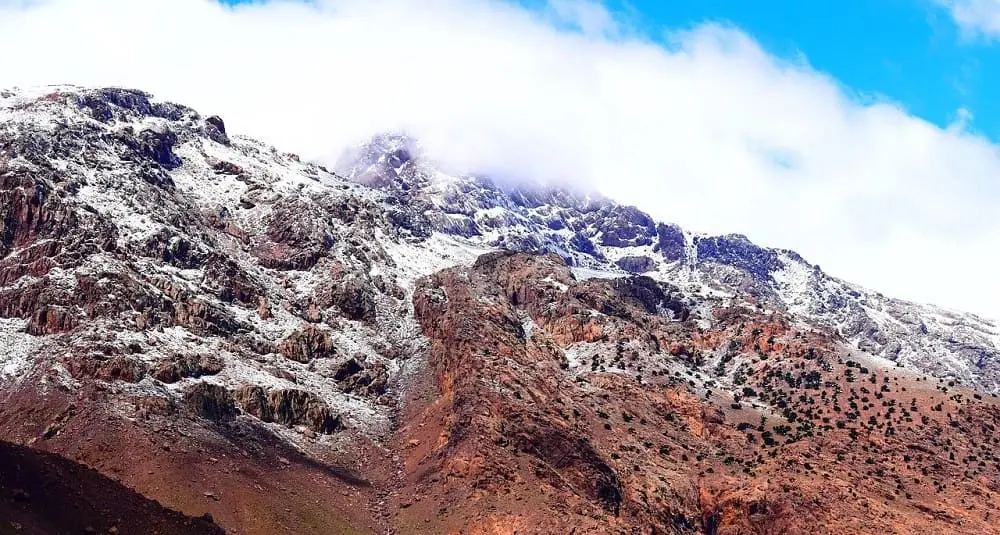What are the mountains called in Morocco?
Last Updated:
The mountains that rise majestically in Morocco bear a name as steeped in history as it is in geography, the Atlas. This vast massif, which also extends over parts of Algeria and Tunisia, plays a central role in Morocco’s natural and cultural identity.
The Atlas ranges are the meeting point between the Mediterranean world, the Sahara and the Atlantic, creating a mosaic of spectacular landscapes, varied climates and human traditions deeply rooted in these high plateaus.
In Morocco, the Atlas is divided into three main sections, the Moroccan Atlas comprises the Middle Atlas, the High Atlas and the Anti-Atlas. Each of these sections has its own characteristics, in terms of relief, vegetation and way of life. The Middle Atlas, for example, is renowned for its cedar forests, a rare and majestic species that finds an ideal refuge in these heights. The High Atlas culminates in Mount Toubkal, North Africa’s highest peak, at over 4,000 meters. Dominating the horizon, it offers a sporting challenge to hikers and mountaineers, while maintaining a strong link with the Berber populations who inhabit its slopes. Finally, the Anti-Atlas, further south, forms a bulwark between the coastal plains and the Saharan expanses, a mineral universe where rocks sculpted by erosion tell the story of millions of years of geological history.
These Atlas Mountains are home to rural, mainly Berber, communities whose customs, language and traditional architecture blend harmoniously into the landscape. The terraced villages, built of earth and stone, often merge with the ochre and brown hues of the peaks. The inhabitants of the Atlas mountains perpetuate a pastoral lifestyle, cultivating cereals and fruit trees, raising goats and sheep, and practicing traditional crafts (weaving, pottery, jewelry) that bear witness to the cultural richness of these regions. The weekly markets, known as souks, are veritable economic and social crossroads, where goods, know-how and information are exchanged to the rhythm of the seasons.
The biodiversity of the Atlas is also remarkable. The flora is particularly varied, from the humid cedar and oak forests of the Middle Atlas to the high-altitude pastures and drought-resistant shrubs further south. This plant diversity is home to an equally rich fauna, Barbary macaques, mouflons, leopards (once present but now very rare), eagles and vultures can all be seen, testifying to a long-preserved ecological balance. Current efforts aim to maintain this biological diversity in the face of demographic pressure, climate change and the exploitation of natural resources.
Historically, the Atlas Mountains have played a strategic and symbolic role. Since ancient times, they have formed a natural barrier protecting civilizations settled on the plains from invasions from the south. Trade routes linking sub-Saharan Africa to the Mediterranean crossed these peaks, making the Atlas a link between several worlds. Successive powerful Moroccan kingdoms have exploited the resources of these regions, whether metals, fertile land or trade routes, while developing agricultural know-how adapted to the constraints of the terrain and climate.
Today, the Atlas is wide open to travelers and nature lovers. Hiking tourism, skiing in the High Atlas resorts, the observation of endemic species and the discovery of unspoilt villages attract large numbers of visitors every year. Local authorities, associations and local residents strive to ensure the sustainable development of this activity, preserving fragile ecosystems and ancestral traditions as far as possible. The Atlas, with its generous nature and cultural heritage, remains one of Morocco’s most emblematic symbols, a geographical landmark and identity mark that continues to exert an immutable fascination on those who contemplate it.
You may also be interested in
geography

What are the mountains called in Morocco?
Answer
In Morocco, the mountains are known as the Atlas Mountains, a vast ensemble that shapes the landscape, home to a rich biodiversity and varied cultures.